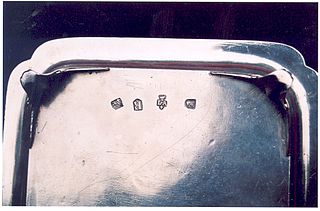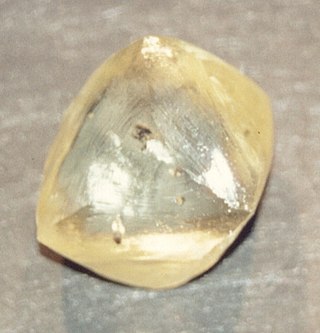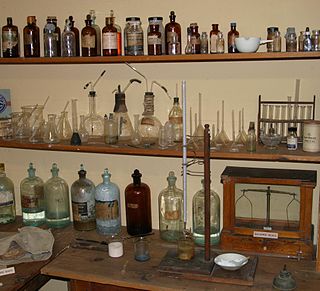
Jewellery consists of decorative items worn for personal adornment, such as brooches, rings, necklaces, earrings, pendants, bracelets, and cufflinks. Jewellery may be attached to the body or the clothes. From a western perspective, the term is restricted to durable ornaments, excluding flowers for example. For many centuries metal such as gold often combined with gemstones, has been the normal material for jewellery, but other materials such as glass, shells and other plant materials may be used.
A hallmark is an official mark or series of marks struck on items made of metal, mostly to certify the content of noble metals—such as platinum, gold, silver and in some nations, palladium. In a more general sense, the term hallmark can also be used to refer to any distinguishing mark.
Assay offices are institutions set up to assay precious metals. This is often done to protect consumers from buying fake items. Upon successful completion of an assay the assay offices typically stamp a hallmark on the item to certify its metallurgical content. Hallmarking first appeared in France, with the Goldsmiths' Statute of 1260 promulgated under Étienne Boileau, Provost of Paris, for King Louis IX.
In modern Western body piercing, a wide variety of materials are used. Some cannot be autoclaved, and others may induce allergic reactions, or harbour bacteria. Certain countries, such as those belonging to the EU, have legal regulations specifying which materials can be used in new piercings.
The fineness of a precious metal object represents the weight of fine metal therein, in proportion to the total weight which includes alloying base metals and any impurities. Alloy metals are added to increase hardness and durability of coins and jewelry, alter colors, decrease the cost per weight, or avoid the cost of high-purity refinement. For example, copper is added to the precious metal silver to make a more durable alloy for use in coins, housewares and jewelry. Coin silver, which was used for making silver coins in the past, contains 90% silver and 10% copper, by mass. Sterling silver contains 92.5% silver and 7.5% of other metals, usually copper, by mass.

Britannia silver is an alloy of silver containing 11 ozt 10 dwt silver in the pound troy, equivalent to 23⁄24, or 95.833% by weight (mass) silver, the rest usually being copper.

The Birmingham Assay Office, one of the four assay offices in the United Kingdom, is located in the Jewellery Quarter, Birmingham. The development of a silver industry in 18th century Birmingham was hampered by the legal requirement that items of solid silver be assayed, and the nearest Assay Offices were in Chester and London. Matthew Boulton and Birmingham's other great industrialists joined forces with silversmiths of Sheffield to petition Parliament for the establishment of Assay Offices in their respective cities. In spite of determined opposition by London silversmiths, an Act of Parliament was passed in March 1773, just one month after the original petition was presented to Parliament, to allow Birmingham and Sheffield the right to assay silver. The Birmingham Assay Office opened on 31 August 1773 and initially operated from three rooms in the King's Head Inn on New Street employing only four staff and was only operating on a Tuesday. The first customer on that day was Matthew Boulton.

Diamonds were largely inaccessible to investors until the recent advent of regulated commodities, due to a lack of price discovery and transparency. The characteristics of individual diamonds, especially the carat weight, color and clarity, have significant impact on values, but transactions were always private. With the standardized commodity as an underlying asset, several market traded financial instruments have been announced.
Argentium silver is a brand of modern tarnish-resistant silver alloys, containing either 94% or 96% silver. Argentium alloys replace some of the copper in the traditional sterling silver with the metalloid germanium. Both argentium 940 and argentium 960 alloys exceed the standard required for hallmarking as sterling silver, and argentium 960 silver meets the standard for hallmarking as Britannia silver.

A silver object that is to be sold commercially is, in most countries, stamped with one or more silver hallmarks indicating the purity of the silver, the mark of the manufacturer or silversmith, and other (optional) markings to indicate date of manufacture and additional information about the piece. In some countries, the testing of silver objects and marking of purity is controlled by a national assayer's office.

The Bureau of Indian Standards (BIS) is the National Standards Body of India under Department of Consumer affairs, Ministry of Consumer Affairs, Food & Public Distribution, Government of India. It is established by the Bureau of Indian Standards Act, 2016 which came into effect on 12 October 2017. The Minister in charge of the Ministry or Department having administrative control of the BIS is the ex-officio President of the BIS. BIS has 500 plus scientific officers working as Certification Officers, Member secretaries of technical committees and lab OIC's.

A metallurgical assay is a compositional analysis of an ore, metal, or alloy, usually performed in order to test for purity or quality.

The Good Delivery specification is a set of rules issued by the London Bullion Market Association (LBMA) describing the physical characteristics of gold and silver bars used in settlement in the wholesale London bullion market. It also puts forth requirements for listing on the LBMA Good Delivery List of approved refineries.
Sara Jocelyn Margarita Elissa Burton was an award-winning British silver and goldsmith. Burton was the first woman to receive the City and Guilds of London Institute top award, the Prince Philip Medal.
India has a comprehensive system of product certifications governed by laws made by the Parliament of India at various times. These certifications are managed by various agencies, and hold various statuses before the law. Some of these marks are mandatory for such products to be manufactured or to be placed in the Indian market while some of the marks hold only an advisory status. All the industrial standardisation and industrial product certifications are governed by the Bureau of Indian Standards often abbreviated as BIS, the national standards organisation of India, while standards for other areas are developed and managed by other governmental agencies.
The Goldsmiths' Company Assay Office in London is the oldest assay office in the United Kingdom. The company has provided hallmarking services since The Goldsmiths Company was founded in the 14th century. The company received its royal charter in 1327 and ranks fifth in order of precedence of the 12 great livery companies of the City of London.
PC Jeweller Limited is a jeweller based in New Delhi, India. It started operations in April 2005 with one showroom at Karol Bagh Delhi and 80 showrooms in India. It is a first generation business promoted by two brothers- Padam Chand Gupta and Balram Garg. It presently has 80 stores in 66 cities across 17 States/UT.
PAMP SA is an independent precious metals refining and fabricating company, and a member of the MKS Group. Established in 1977 in Ticino, Switzerland, the company originally started as a minting facility for bars weighing less than 100 grams and as an alloy specialist for the jewelry and luxury watch-making industries. It has since expanded to provide a full range of services, from collecting doré from mines to assaying, hedging, and delivering its bars and other products. PAMP produces bullion bars ranging from 1 gram to 12.5 kilograms.
Kundan Group was established in 1971 and is headquartered in New Delhi, India. The company has a multi-business portfolio inclusive of gold refinery, cosmetics, chemicals, polymers, agro-commodities, precious metals, petroleum products, energy, and the import of bullion and pharmaceutical items.








